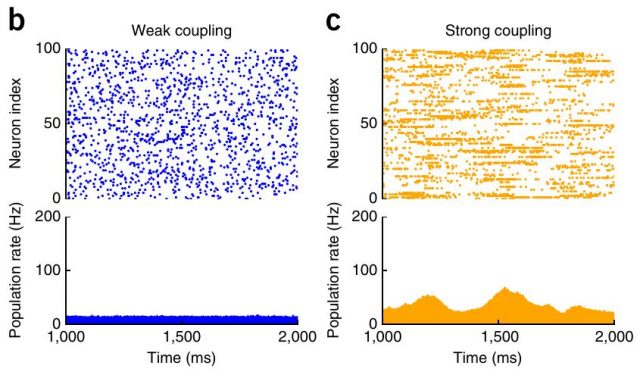A new type of spontaneous activity in the brain identified
The study of the spontaneous activity in the brain –and its origin– is one of the major puzzles in modern neural science. In many situations, the same neurons which behave smoothly and in an easily predictable way in in vitro experimental conditions, turn into unpredictable units, firing spikes irregularly and even chaotically, when they are in their natural medium surrounded by thousands of other neurons. The neural activity that we can find in vivo in the cerebral cortex is therefore highly irregular, and a wide variety of explanations have been proposed for this “erratic” behavior at the cellular level: thermal fluctuations affecting the ionic channels, complex connectivity patterns and the intrinsic noisy nature of external sensory stimuli are among the most popular explanations.

An interesting idea concerning the origin of irregularity in the brain, proposed by theoretical neuroscientists more than a decade ago, is that irregularity arises as the result of a balanced input onto neurons 1. If, say, the average excitatory and inhibitory currents arriving to a neuron are both very strong, they will approximately cancel each other, and the remaining fluctuations that survive such a cancellation will be the forces responsible for driving the activity of the neuron. Because of this net input being stochastic, the resulting spike train of the neuron will be irregular, as observed experimentally –and such irregular output will boost the activity of the surrounding neurons to maintain the strong activity and “keep the wheel spinning”.
Cortical neurons in this balanced state, while displaying the irregular activity probed experimentally, do not seem to be well fit to accommodate complex cortical computations. In the presence of an external input, the response of each of the neurons in the network will be statistically equivalent, leading to a high degree of computational redundancy in the response of the neural network. Traditionally, neuroscientists have thought therefore that more intricate calculations would be carried out by populations of neurons, instead of by neurons themselves. A good indicative of this theory is that a population of neurons, as a whole, displays a slower time scale that the individual neurons that constitute the population. A slower time scale would allow for interesting phenomena, such as stimulus integration over time, manipulation of information, and retention or short-term memory. In such a framework, therefore, cortical populations of neurons would process the information to form concepts and abstract representations, while individual neurons would be merely in change of efficiently transmitting the information across the brain with unnecessary distortion.
This classical framework has been carefully reexamined recently. Srdjan Ostojic, from the École Normale Supérieure of Paris, France, has provided a new theoretical hypothesis in a recent article published in Nature Neuroscience 2. According to detailed numerical simulations of networks of biophysically realistic neurons, a classical unstructured, sparsely connected network of balanced excitatory and inhibitory neurons is able to display two different types of spontaneous asynchronous activity, depending on the average strength of the synaptic connections in the network. For weak synaptic connections, the network at rest is in the well-known asynchronous state, in which neurons fire erratically (as a consequence of the balanced input condition) at approximately constant rates. In this situation, any external input will produce a global, redundant response by the population of neurons receiving the input, as explained above.

For strong synaptic connections, however, a new regime is revealed by numerical simulations: the network at rest displays a rich and complex internal dynamics, with firing rates of individual neurons fluctuates strongly in time and also across neurons. Neurons in this situation would, therefore, display a doubly-stochastic nature: the firing of spikes for a given firing rate value will be stochastic, and also the firing rate itself would fluctuate in time. A similar doubly-stochastic effect was recently identified in balanced networks with a complex topological structure (i.e. forming connectivity clusters) 3, although the existence of this phenomenon in unstructured balanced neural networks constitutes a benchmark.
Further numerical simulations and, ideally, some sort of mean-field approximation to the phenomenon would be desirable to test whether the dual nature of stochastic neural activity reported where can indeed occur in realistic spiking neural networks. If this is confirmed, a doubly-stochastic process like the one reported by Ostojic would provide a proper substrate for complex information processing and high-level cortical computations.
References
- C. A. van Vreeswijk and H. Sompolinsky. Chaos in neuronal networks with balanced excitatory and inhibitory activity. Science 274, 1724-1726, 1996 ↩
- Ostojic S. (2014). Two types of asynchronous activity in networks of excitatory and inhibitory spiking neurons, Nature Neuroscience, 17 (4) 594-600. DOI: http://dx.doi.org/10.1038/nn.3658 ↩
- A. Litwin-Kumar and B. Doiron, Slow dynamics and high variability in balanced cortical networks with clustered connections. Nature Neuroscience, 15, 1498-1505, 2012 ↩